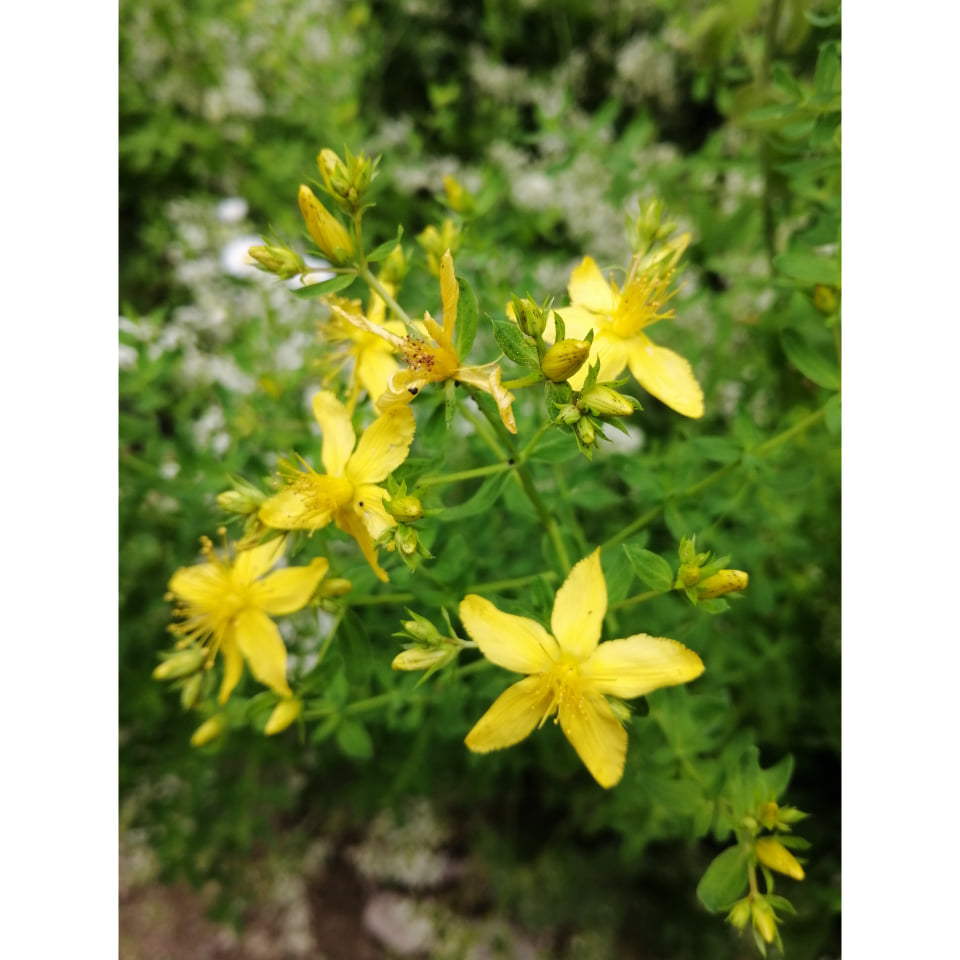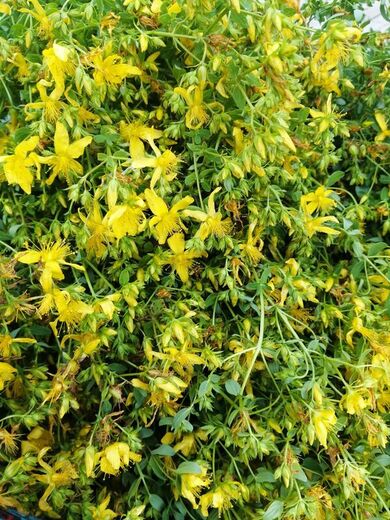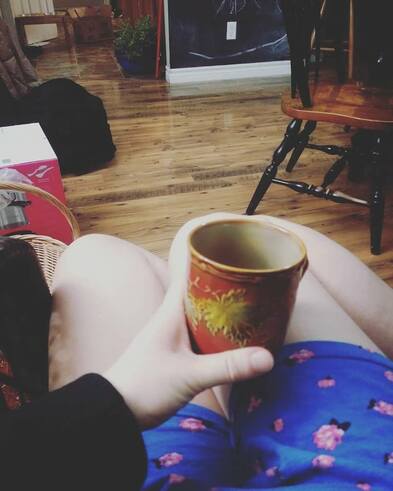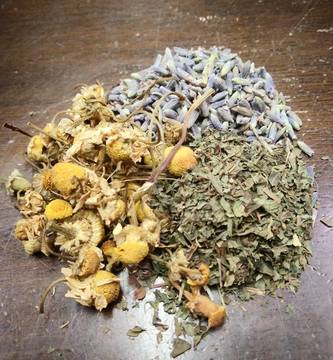|
St. John's wort (Hypericum perforatum) is in full bloom in New Brunswick right now. It is a beautiful plant, with cheerful yellow flowers. It has quite a distinct smell, and some very unique characteristics. It can grow several feet tall, and has a woody base. The flowers grow in clusters at the end of the branches. Each flower is bright yellow, has five petals, numerous stamen, and a single pistil. The leaves and flowers have small black dots. The leaves, if held up to the light, are peppered with transparent 'holes' (actually oil glands), which makes sense when you consider the latin name of the plant, perforatum (perforation). Possibly the coolest part of the plant, though, is that despite it's cheerful yellow colour, it 'bleeds' a dark purple. Squeeze a plump flower bud between your fingers, and it will stain your fingertips dark purple. St. John's wort has been extensively studied for its actions against mild and moderate depression. It has gained such a solid reputation as an antidepressant that it isn't strange anymore to have allopathic doctors recommend it to their patients who wish to avoid pharmaceutical antidepressants. It is not, however, a pharmaceutical and lacks the instant action that some people have come to expect from man-made drugs. It needs to be taken over a period of time for its full effect to be felt, at least 2-3 weeks, and often months. Used properly, it is very effective due to the herb's active constituents. These increase the serotonin levels in the body, and level out the 'feel-good' neurotransmitters of dopamine, serotonin, and noradenaline to make them last longer in the body. Topically, St. John's wort is wonderful for soothing and healing bruises, sore muscles, sprains, and burns. It is best used as an oil in this case. The oil and tincture must be made with fresh buds and flowers for it to be effective because the hypericin (active constituent) does not last as well in the dried plant matter. So, the few weeks when St. John's wort is ready is a very busy time of oil and tincture making! To know when the plant is ready, squeeze a bud between your fingers. If it is filled with purple 'juice', it's time. These flowers and buds are at their peak. Most of the plant is at the bud stage, which is best. The buds are plump and juicy and ready to be made into remedies! St John's Wort Tincture St. John's wort flowers and buds vodka glass jar with lid label Method: 1. On a bright, warm day, pick enough St. John's wort buds and flowers to fill a glass jar 3/4 full. The plant matter should be fairly packed, but not too tightly. 2. Fill the jar with vodka (80 proof, or 40% alcohol) so there is very little headspace. The alcohol must completely cover the plant matter. Use a spoon to smoosh down the herbs if they float. 3. Cap the jar, being sure to put a non metal barrier between the alcohol and the lid. Parchment paper or plastic wrap works well. 4. Label with the ingredients and date. Store in a dark, cool cupboard for 6 weeks, shaking daily. The tincture will be a deep red colour. DOSE: Generally, 1/2 to 1 tsp twice daily. Cycling is important. Take it for 3 weeks, discontinue for 1 week, and repeat. SAFETY: Some people experience photosensitivity when taking St. John's wort. Discontinue if you experience skin issues. St. John's wort should not be taken in conjunction with pharmaceutical antidepressants without the guidance of your doctor. If pregnant or breastfeeding, seek the guidance of a health-care practitioner. ** This is fun, right?! And that's all it is for now. Information on the traditional uses and properties of herbs in this website are for educational use only, and are not to be mistaken for medical advice. Every attempt has been made for accuracy, but none is guaranteed. Many traditional uses and properties of herbs have not been validated by the FDA or Health Canada. If you have health issues, concerns, or questions, consult your health care practitioner. ** More info: Gladstar, Rosemary, Medicinal Herbs A Beginner's Guide, Story Publishing, North Adams, MA. 2012 https://www.ediblewildfood.com/st-johns-wort.aspx
0 Comments
Yes, it's another unflattering picture, but it's real and it has significance...two things I love. I have become an early riser. I love the quiet as I sip my coffee, daydream and organize my thoughts. The hour to myself before the kids wake is such therapy! Lately, my early morning thoughts have gone toward my emotional progess. I am very much a person who fixes. There was a time I struggled ...with a saviour mentality. Hard times? World poverty? Second cousin twice removed had surgery? Emilie to the rescue! My thoughts and behaviours, trying to be everything to everyone, running ragged to solve problems as big as maternal death in the Phillipines and as small as a friend's rocky marriage left me exhausted mentally and physically. Burnout after burnout left me in shambles. So I stopped. I am able to recognize my level of energy reserves. I am able to recognize my abilities in a realistic way.
I have the desire to take care of everything and everyone, but I now have the sense to say no and feel okay with it. Saying no to some responsibilities has given me the ability to do well in others. For the New Year, choose one task that is suited to you and do it well. If you hate cooking and crowds make you anxious, don't volunteer in a soup kitchen. Let that be another's blessing. Perhaps you'd be better suited to helping the soup kitchen by doing administrative work or cleaning the hall after events. Don't fight who you are. We've all been made differently not to compete, but to compliment each other. The holidays have come and gone, and I admit I am imperfect. Every year I swear that this will be the year I have it all together, house clean, children scrubbed and smiling, myself scrubbed and smiling (!), gifts wrapped, yummies baked, and decorations strung throughout the house and yard. Every year, and again this year, it was not to be. The house got cleaned, and the yummies were baked, but the smile was a tad forced. Although I love the hustle and bustle of the Christmas season, I am not immune to the stress that comes along with it. On top of all this, I developed an abscessed gum, which traveled from one side of my mouth to the other. How it managed this, I'm unsure, but there it is. I successfully treated the first abscess with Drastix tincture (topically and internally), but am still working on the second one which seems more severe. All this to say, stress got the better of me. In an effort to soothe my frazzled nerves, and also deal with the abscess, I sought herbs that are both calming, antibacterial, and anti-inflammatory. I had made Peace Tea before, and felt that it fit the bill perfectly. The chamomile is a gentle herb that is best known for it's calming effect. It's also wonderful for stomach complaints, which often accompany anxiety. What some don't realize is that chamomile is also wonderfully antibacterial, antiviral, and an excellent anti-inflammatory. Lavender has many of the same properties, and is an even stronger calming herb. Last, but certainly not least, comes the lemon balm. With its pleasant minty, lemony flavour, it contributes greatly to the taste of the tea. It is a calming herb, too, and strongly antibacterial and antiviral. It should not be used by those with a hyperactive thyroid, however. In this case, peppermint is a nice substitute! Give it a try, and let me know what you think! Peace Tea
2 parts chamomile flowers 1 part lavender buds 2 parts lemon balm (or peppermint) Blend the herbs. Use a spoonful in a cup of just boiled water. If drinking for pleasure, steep covered for 2-3 minutes. Any longer will result in a bitter tea. For a therapeutic tea, steep covered for 10 minutes. Sweeten with honey as desired. |
Emilie
Clinical herbalist. Mother. Teacher. Ever student. Archives
February 2022
Categories
All
|





 RSS Feed
RSS Feed